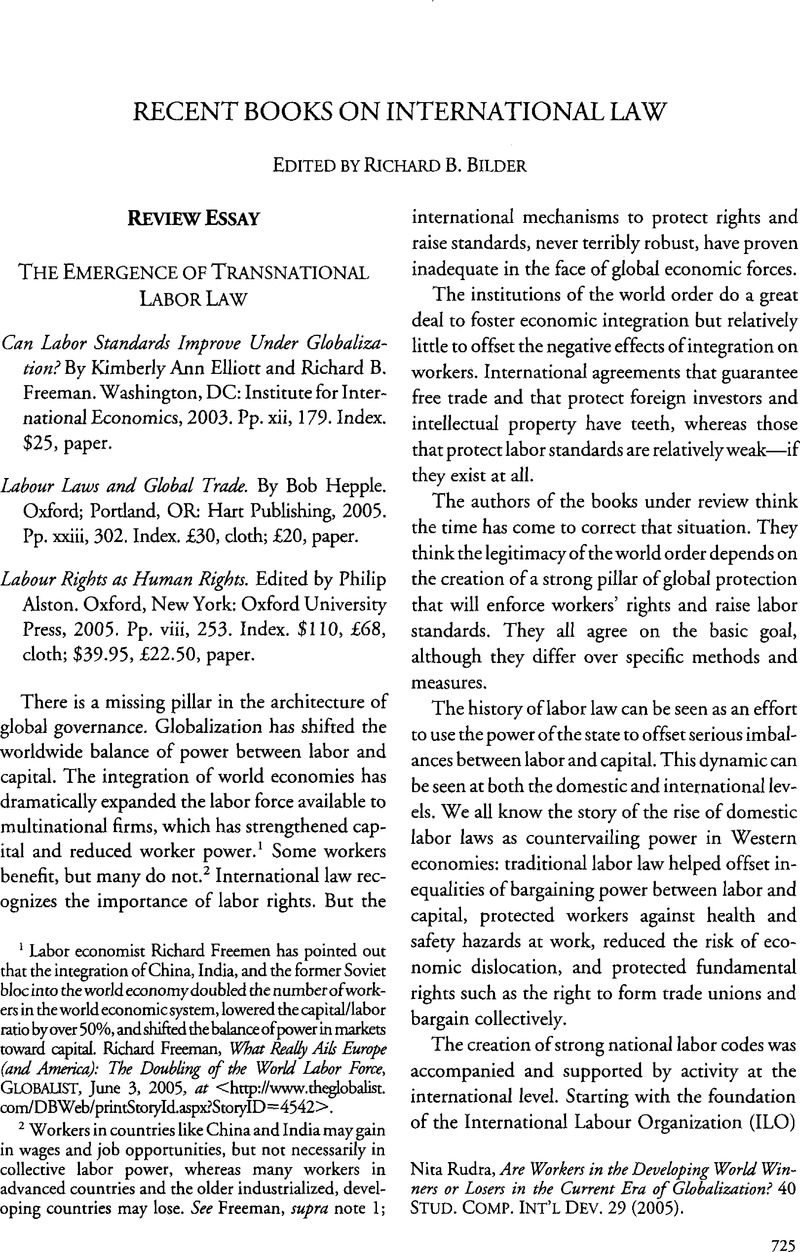Published online by Cambridge University Press: 27 February 2017

1 Labor economist Richard Freemen has pointed out that the integration of China, India, and the former Soviet bloc into the world economy doubled the number of workers in the world economic system, lowered the capital/labor ratio by over 50%, and shifted the balance of power in markets toward capital. Richard, Freeman, What Really Ails Europe (and America): The Doubling of the World Labor Force, Globaust, June 3, 2005 Google Scholar, at <http://www.theglobalist.com/DBWeb/printStoryId.aspx?StoryID=4542>.
2 Workers in countries like China and India may gain in wages and job opportunities, but not necessarily in collective labor power, whereas many workers in advanced countries and the older industrialized, developing countries may lose. See Freeman, supra note 1; Nita, Rudra, Are Workers in the Developing World Winners or Losers in the Current Era of Globalization? 40 Stud. Comp. Int’l Dev. 29 (2005)Google Scholar.
3 For a discussion of this system, see my review of Governance in a Globalizing World (Joseph, Nye and John, Donahue, eds.) in this Journal (96 AJIL 748 (2003)Google Scholar).
4 The author of this review counts himself among the transnationalists. For another description of the emerging transnational labor regime, see David, M. Trubek & Lance, Compa, Trade Law, Labor, and Global Inequality, in Law and Class in America 217 (Paul, D. Carrington & Trina, Jones eds., 2006)Google Scholar. See also David, M. Trubek, Jim, Mosher, & Jeffrey, S. Rothstein, Transnationalism in the Regulation of Labor Relations: International Regimes and Transnational Advocacy Networks, 25 L & Soc. Inquiry 1187 (2000)Google Scholar.
5 A recent book, Globalization and the Future of Labor Law, edited by John R. Craig and S. Michael Lynk and containing numerous essays, covers many of the same topics as Labour Laws and Global Trade but was published too late to be included in this review. For a comprehensive collection of literature on globalization and labor, see the Web site Globalization and Labor Standards, <http://www.laborstandards.org>, organized by Katherine van Wetzel Stone of UCLA School of Law.
6 For a discussion of all these issues, see Trubek & Compa, supra note 4.
7 Sen’s work (see, for example, Amartya, Sen, Development as Freedom (1999)Google Scholar) has led commentators to argue that human rights, including labor rights, should be considered to be part of development, not merely a means toward, or by–product of, development. For a discussion, see David, M. Trubek & Alvaro, Santos, Introduction to The New Law and Economic Development: A Critical Appraisal 1 (David, M. Trubek & Alvaro, Santos eds., 2006)Google ScholarPubMed.
8 The idea that labor law can increase, not decrease, competitiveness is offered as one reason why the much feared race to the bottom has not occurred. Hepple argues that some countries have used strong labor regulation as part of a complex system of economic coordination that gives them a comparative advantage in certain areas of world trade. His specific reference is to the coordinated market economies (CMEs) of Japan and northern Europe. He writes that “in CMEs. . . governments should be less sympathetic to deregulation because this threatens their country’s comparative institutional advantage from regulatory regimes that that support non–market methods of coordination” (Labour Laws and Global Trade, p. 252). At a time when many of the so–called CME economies are suffering from low growth and high unemployment, and pressure is building in many key countries to weaken various aspects of CME labor law, including worker participation, lifetime job security, and national–level bargaining, it is not so clear that these countries are as immune from the pressures of globalization on their labor regimes as Hepple suggests.
9 For a description of the OMC, see James, S. Mosher & David, M. Trubek, EU Social Policy and the European Employment Strategy, 41 J. Common Mkt. Stud. 63 (2003)Google Scholar. A comprehensive review of research on the OMC can be found in Jonathan, Zeitlin, The Open Method of Coordination in Action: Theoretical Promise, Empirical Realities, Reform Strategy, in The Open Method of Coordination in Action: The European Employment and Social Inclusion Strategies 447 (Jonathan, Zeitlin & Philippe, Pochet eds., 2005)Google Scholar.
10 See, e.g., Lance, Compa, NAFTA’s Labor Side Agreement and International Labor Solidarity, in Place, Space and the New Labour Internationalisms 147 (Peter, Waterman & Jane, Wills eds., 2001)Google Scholar.
11 The case is described in detail in Maupin’s chapter in Labour Rights as Human Rights. It is not clear how much independent impact can be attributed to the ILO’s actions since the countries that imposed sanctions had done so before the organization acted.
12 Robert Howse, a well–known trade law scholar, and Makau Mutua, a human rights expert, have argued that the WTO could allow such bans under existing law. See Robert, Howse & Makau, Mutua, Protecting Human Rights in a Global Economy: Challenges for the World Trade Organization (Int’l Ctr. for Human Rights & Democracy Policy Paper, 2000)Google Scholar, at <http://www.ichrdd.ca/publications>. Many observers feel, however, that an amendment would be required to legalize such actions.
13 The primary exceptions are Elliott and Freeman’s positive assessment of the effects of consumer advocacy and Charnovitz’s very negative reading of prospects for a strong labor dimension in the FTAA.
14 For one discussion of transnational labor advocacy by unions and NGOs, see Trubek et al., supra note 4.